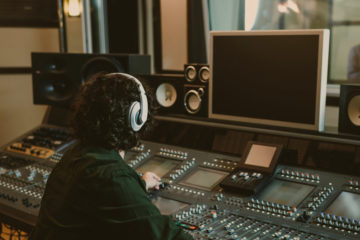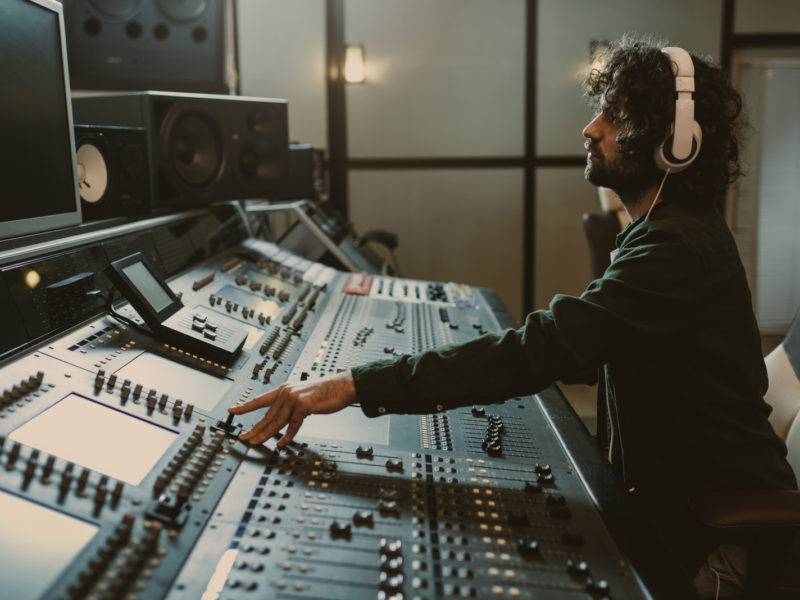How to Charge AirPods Without a Case
Discover the truth about how to charge AirPods without a case. Uncover myths, find alternatives, and safeguard your audio experience.

If you’ve ever noticed that your favorite song sounds different depending on what headphones you’re using, don’t worry, you’re not crazy.
In fact, this can often be an intentional choice by the manufacturer to emphasize certain aspects of the listening experience.
Monitor headphones, on the other hand, do no such thing. They try to keep the audio as close to how it was originally recorded as possible, with no added bells and whistles.
Monitor headphones (also called studio headphones) are designed to give the listener as much clarity of sound as possible (that’s why podcasters wear headphones to monitor their voice) in order to make an accurate judgement of each individual instrument or audio component of a song without modifying the bass, mids or treble. They are usually used for tracking audio, “monitoring” or mixing audio, and mastering audio.
Aside from having studio headphones or monitor headphones, I also recommend you to have good studio monitors so you can listen to your recording from a loudspeaker as well. With this being said, I recommend the Mackie CR3-X which you can get for a reasonable price.
There are 3 main differences between monitor headphones and regular, consumer headphones. These are differences in frequency response, durability, and comfortability.
Frequency response refers to the range of sound that human ears are typically able to hear and understand, and an audio device’s ability to “respond” to that range.
Our ears can typically hear a frequency range of 20Hz-20,000Hz (20Hz being the deepest bass frequencies and the 20,000Hz being the highest treble frequencies). Monitor headphones have the ability to “respond,” or communicate that range to our ears, and can sometimes even extend beyond that range.
Monitor headphones’ frequency response allows our ears to hear everything that was actually recorded in the song in the exact way that it was recorded.
Monitor headphones have a “wide” and “flat” frequency response.
The range of frequencies that monitor headphones communicate is wider than most consumer headphones, allowing the listener to hear more frequencies.
This range is also flatter because monitor headphones do not emphasize or “amplify” any frequency over another.
The range of frequencies is “flat,” meaning no frequencies are boosted or manipulated.
An example of boosting frequencies would be brand name consumer headphones that typically boost the bass of their frequency response to give the listener a more satisfying listening experience.
This may sound familiar to some of you who put on a pair of headphones and are blown away by how huge the bass sounds, and judge their quality based on that feature. And there’s nothing wrong with that!
Most listeners enjoy a boosted bass because it tends to give the music more depth and perceived dimension. This is especially true of more modern pop and hip hop music where the bass is often the centerpiece.
What you can lose from boosted bass headphones is some of the accuracy and character of the song as it was initially intended to be heard.
In a nutshell, with monitor headphones, the frequency response allows you to hear more frequencies with more accuracy, without any of the added frequency manipulation that consumer headphones tend to add as features, like bass boosting.
Durability refers to the materials used to make the headphones and the overall “build quality.”
Since monitor headphones are typically used for long periods of time in professional studio settings, they need to be able to withstand that extended use.
For example, the Beyerdynamic DT 770 Pro’s are monitor headphones that are built to last.
They are made of high-quality, thick plastic, with metal yokes holding the adjustable leather-covered headband.
If you’re tracking in the studio and your monitor headphones get passed around or dropped to the ground, you can be sure the build quality is just as strong as the sound quality.
Consumer headphones can definitely be durable, but tend to be built for more casual listening.
Learn how to tell if headphones are blown in this article.
Comfortability refers to how comfortable the fit is.
If you’re going to be wearing your headphones for hours on end (drummers especially), they better be comfortable!
Monitor headphones make comfortability a priority.
While comfort may mean different things to different listeners, weight and fit are cornerstones.
The weight of monitor headphones may vary from brand to brand, but a weight hovering somewhere around 9 ounces was found by our testing team to contribute to the overall comfort of a pair of Sennheiser HD600 monitor headphones, as an example.
The fit of monitor headphones definitely varies from brand to brand, as well as a listener’s preference.
You may prefer earpads with memory foam that are covered in soft materials like the Sennheiser’s, or you may prefer a simple leather covering if you’re concerned about heating.
Either way, monitor headphones have a variety of fits and can be worn for long listening sessions without getting fatigued.

Side view of sound producer working at studio
Monitor headphones are often used for tracking, mixing and/or mastering recorded audio. But they’re really designed for any long-listening experience where accuracy and clarity are appreciated.
These monitor headphones are examples of affordable headphones like the OneOdio Monitor 60 that are great for long-listening, whether you’re working with audio or just value accuracy and clarity when listening.
If you are tracking over previously recorded audio, it helps to hear each individual instrument clearly so you can adjust your timing as needed and know what is going on in the song you’re tracking on.
Tracking to a song where you can only hear the boosted bass, or you can’t quite catch a snare hit, for example, can impede your ability to efficiently execute a performance.
Monitor headphones guarantee that you will hear the audio exactly how it was prepared for you, so you can track accordingly.
Mixing audio is all about adjusting recorded sound to fit the needs of the overall audio project.
If you are mixing audio you definitely want to use monitor headphones.
Similar to the tracking example, you want to know what is going on in the song or piece of audio, but you also want to be able to manipulate that sound on your own terms.
If you are using consumer headphones with fine-tuned acoustics and boosted bass frequencies, you are not going to have an accurate understanding of what your audio actually sounds like.
Sure, the bass might sound great but it’s not going to make mixing any easier!
Mastering audio is the post production process of preparing and transferring recorded audio to a source (the master), which all copies can be produced from.
When mastering audio it is absolutely critical that you are listening to the audio as it was originally recorded and intentionally mixed.
You definitely do not want to master audio with consumer headphones that alter frequencies because you could end up changing the entire vibe and feel of the song!
That really depends. Before deciding to purchase monitor headphones it’s important to ask yourself what you’ll be using them for. What is the goal of your listening experience?
If the answer is, you will be using them for one or all of the three steps used in audio production (tracking, mixing, mastering), the answer is YES!
If you are just entering the world of music production or audio production of any kind, monitor headphones are a must.
If you are not familiar with them, they may take some getting used to but they are an effective tool for anyone hoping to make polished, well-monitored audio.
If the answer is, listening to music on my commute or in a casual setting, the answer is MAYBE.
Some music lovers appreciate the intimacy and connection to a song that comes from hearing the song as it was originally recorded and intended to be heard. They also want to be able to discern every element of the song that was included for a reason.
Bass boosting, while epic and exciting, can cloud some of those intricacies and leave the song feeling one dimensional.
But, taste is taste!
If you want headphones that bump the lows and make the highs really shine, go with regular headphones. Most consumer headphones may have a narrower frequency range, but specialize in bass boosting.
Headphones are a crucial audio device for listening to and enjoying recorded audio. But it can be overwhelming trying to figure out which brand and type is right for you.
If you are new to the wide world of headphones and aren’t quite sure if monitor headphones are the path for you, check out our headphone buying guide to see which model best fits your preferences.
This guide will go into depth on the three types of headphones on the market: in-ear headphones, on-ear headphones and over-ear headphones.
All 3 have distinct advantages and disadvantages when considering sound quality, portability, build quality and comfort level, so it’s really up to you which is most important. There’s no right or wrong answer!
If you’re looking to buy a quality pair of monitor headphones, check out our buying guide. If you’re a little more budget conscious, we have another guide on the best studio headphones under $100). There are definitely other factors to consider when buying headphones of any kind, but sound quality is usually going to determine how high the price gets. Higher-end headphones are going to have better sound quality, while cheaper models will tend to suffer in that category.
Monitor headphones are designed to deliver clear and accurate audio that reflects how the audio was originally recorded.
Monitor headphones are great for work in audio production because of their accuracy, durability and comfortability, but these same features make them a perfect fit for anyone seeking an authentic, long-listening experience.
But if long-listening isn’t your thing, or you just want that bass to really hit, monitor headphones probably aren’t for you.